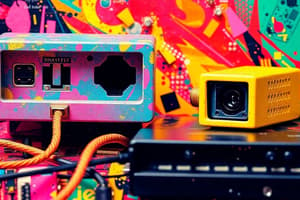Podcast
Questions and Answers
Which of the following is not an input device for a computer?
Which of the following is not an input device for a computer?
- Mouse
- Light Pen
- Speaker (correct)
- Keyboard
Joystick is mainly used in Computer Aided Designing (CAD) and playing computer games.
Joystick is mainly used in Computer Aided Designing (CAD) and playing computer games.
True (A)
The ________ is an input device used in banks for processing large number of cheques daily.
The ________ is an input device used in banks for processing large number of cheques daily.
MICR
Match the following types of printers with their description:
Match the following types of printers with their description:
What is the primary function of the Motherboard?
What is the primary function of the Motherboard?
Flashcards are hidden until you start studying
Study Notes
Introduction to Computer Organization
- Computer organization deals with the hardware and software components of a computer system
Input Devices
- Keyboard:
- Types: 84 keys, 101/102 keys, 104 keys, 108 keys
- Functions: typing keys, numeric keypad, function keys, control keys, special purpose keys
- Mouse:
- Pointing device
- Used for selecting items on the screen
- Joystick:
- Pointing device
- Used in computer-aided designing (CAD) and playing computer games
- Light Pen:
- Pointing device
- Used to select menu items or draw on the screen
- Scanner:
- Input device
- Works like a photocopy machine
- Microphone:
- Input device
- Input sound, stored in digital form
- Magnetic Ink Card Reader (MICR):
- Input device
- Used in banking to process large number of cheques
- Optical Character Reader (OCR):
- Input device
- Reads printed text, converts to machine-readable code, stores in system memory
- Bar Code Reader:
- Input device
- Reads bar coded data
Output Devices
- Monitors:
- Types: Cathode-Ray Tube (CRT), Flat-Panel Display Monitor
- Characteristics of CRT: large in size, high power consumption
- Characteristics of Flat-Panel Display Monitor: reduced volume, weight, and power requirement
- Printers:
- Types: Impact Printers, Non-Impact Printers
- Impact Printers:
- Characteristics: low consumable costs, noisy, useful for bulk printing
- Types: Character Printers, Line Printers
- Non-Impact Printers:
- Types: Laser Printers, Inkjet Printers
- Characteristics of Laser Printers: high speed, high quality output, good graphics quality
- Characteristics of Inkjet Printers: high quality printing, reliable, expensive
System Unit Components
- Motherboard:
- Primary device of the system unit
- Connects all computer devices (video card, RAM, sound card, hard drive, etc.)
- Processor (CPU):
- Performs billions of mathematical calculations per second
- Consists of ALU, Memory Unit, and Control Unit
- RAM (Random Access Memory):
- System memory
- Connected directly to the motherboard
- Hard Drive:
- Mechanical drive that works on magnetic recording
- Central storage of data on most computers
- Video Card (Graphics Adapter):
- Graphics accelerator
- Generates and displays images
- Power Supply:
- Converts electrical energy into direct current required by the computer
CPU Components
- ALU (Arithmetic Logic Unit):
- Performs arithmetic and logic operations
- Memory Unit:
- Stores instructions, data, and intermediate results
- Control Unit:
- Controls the operation of all parts of the computer
Motherboard and Ports
- Motherboard:
- Connects all parts of the computer together
- Provides ports for connecting external devices
- Ports:
- Types: Serial Port, Parallel Port, PS/2 Port, USB Port, VGA Port, Power Connector, Firewire Port, Modem Port, Ethernet Port, Game Port, DVI port
- Characteristics of each port type
Studying That Suits You
Use AI to generate personalized quizzes and flashcards to suit your learning preferences.




